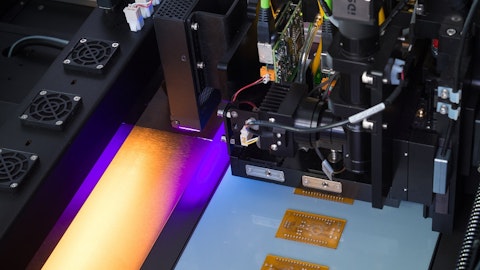So that’s where the focus will be. We really won’t be touching R&D and marketing and sales. So we believe this – this destocking period is temporary, and so we really need to be prepared when it comes back on the other side to be able to take advantage of the upside. So that really won’t be the focus to be more on the plant costs and the functional spend.
David Begleiter: Understood. And then just on interconnects and semis, did you gain any share this year? Or is there any new technology products in the pipeline that you think can grow share this year or next year?
Lori Koch: Yes. So there’s examples in both. So within semi, really around the packaging side, we’ve seen some nice share gains. And also just in general, we’ve seen an uptick on the advanced new components. And so if you actually look at our performance in the quarter, we had nice growth with TSMC as they continue to expand their advanced nodes and take advantage of the AI revolution. So we saw nice growth on the semi side. And then within ICS, we had a new application with 1 of the large smartphone producers, which took advantage of a material that crossed over our metallization business to be able to have a key win there. So that was part of the sequential growth that we saw in the quarter will we continue to be. It’s on every single model of the phone, but with a one producer, so it’s a nice vendors.
David Begleiter: Thank you.
Operator: Your next question comes from the line of Aleksey Yefremov of KeyBanc Capital Markets. Your line is open.
Aleksey Yefremov: Thanks and good morning, everyone. This is Rob in for Aleksey. My first question comes around the Shelter Solutions business. Just in terms of where do you think we are in the destocking cycle there in demand? And then how good is your visibility into 2024 here?
Lori Koch: Yes. So we saw less of a year-over-year headwind in Shelter in the third quarter versus what we saw in the first half that we feel like things are starting to normalize a little bit and then our expectations for the fourth quarter are to see less volume declines, less we’re seeing year-to-date. So it feels like things are normalizing a little bit. Obviously, there’s a little bit of disparity from a market perspective between the resi and the commercial side. A lot of the growth that was on the commercial side is more in commercial applications where we don’t have a big footprint like, for example, around the data centers. Our exposure in commercial is more around education and healthcare and government, where there hasn’t been that step change growth, it’s really been more on the data center side.
But in general, it feels like we’re nearing the end of the significant downturns. We expect the volumes in the fourth quarter to be more down in the mid-single digits versus the double-digits that we’ve seen all year. So it feels like it’s starting to normalize, and we do believe that destock is now behind us. So now it’s just a function of when the demand returned.
Aleksey Yefremov: Okay. Very helpful. Thank you. And then just a question for me on – you mentioned China trade restrictions and the impact it had on the semiconductor technologies business. Wondering if you might be able to quantify that impact there. And then just any updated view on the recently announced restrictions there? Thank you.
Lori Koch: Yes. So no change to our current view of about $60 million of a revenue headwind from the exposure. So a lot of our…
Ed Breen: For the year.
Lori Koch: For the year, yes. So it’s about $15 million of order. So a lot of the restrictions have more been in the advanced node spaces that we don’t have a huge footprint with the Chinese players from that perspective. So it’s only about $60 million for us.
Operator: Your next question comes from the line of Josh Spector of UBS. Your line is open.
Josh Spector: Yes, hi. Thanks for taking my question. So I just wanted to ask on fourth quarter. I mean it kind of seems like the puck is moving around in different areas in terms of destocking. But if I heard you right, your sales guidance is kind of flattish in the different segments sequentially. Semis is picking up, which has the highest drop-through, and you’re expecting some higher raw material benefits. So what would drive EBITDA down sequentially $20 million, $25 million versus flat to up?
Lori Koch: Yes. So we see the underlying revenue down about $100 million once you – on an organic basis. So we will get another quarter of the Spectrum business first third quarter. But if you take that out, we see underlying organic revenue down about $100. So it’s about split between seasonality and currency being about half of the headwind with the seasonality being within the – primarily the smartphone and consumer electronics business in ICS and Shelter as they strength throughout the summer months. And then currency, we do see as a bit of a headwind sequentially. And then the other half of it is from the medical packaging piece that Ed had mentioned earlier. So we do see some medical packaging pullback in the fourth quarter as those device makers destock from the overbuy that happened over the recent quarters.
So it’s really just and then the EBITDA, you have a net benefit from additional spreads. We have mentioned there’s about $25 million of additional benefit from spread, but that $100 million impact from the volume decline kind of net you out to the surrounding the $50 million that we guided to for the fourth quarter versus the $775 million that we posted in the third quarter.
Josh Spector: Okay. Thanks. I appreciate that. And I mean, just if you kind of come back to electronics and semis. I think Ed, you said utilization rates in the mid-70s. I think we’ve maybe troughed in the high 60s, but you guys haven’t really felt as much of that pickup. I guess, as you look at things improving, how much is semi reconnecting your business year-on-year just from a reconnection to where the rate is now? I mean, is that mid-single digits or higher, just on where we’re resonating now perhaps inventory or it would be a different math to get to a different level? Thanks.
Ed Breen: Well, the fabs have been – to your point, have been running kind of if you lump them all together. I think you would average out in the high 60s. And I think if you go through all the projections out there and also talking to our customers, that high 60s is going to ramp through 2024, up to – by the time you get maybe in the third quarter, beginning the fourth quarter up to maybe a little over 80%. So you still won’t be back according to projections to kind of over 90% till you enter into 2025. But again, going from high 60s to 80% is a nice lift during the year. And then more of that production will be advanced nodes, which back to Lori’s point a minute ago, plays to our strength that’s usually why we outgrow 200- to 300-basis-point what the market is doing.
But it’s also – by the way, you also got to look customer by customer on the semi side because some are still – we’re shipping out of inventory. But all the signs I saw from all their reporting publicly, they’ve seen their bottom, it looks like, pretty much across the board. But I don’t think the lift will be dramatic in the – at the beginning of the year. But I think as the year sequences, we’ll see nice lift occurring in that business.





